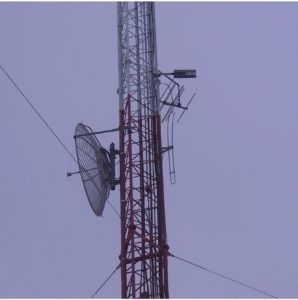Chuck Scott – N8DNX
Ham Radio in Northern Michigan
Antennas at Stutsmanville Repeater Site
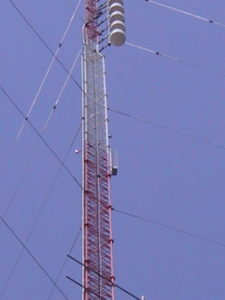
UHF Receive Antenna
On the right side of the tower near the center of this picture is the 8 bay Sinclair UHF receive antenna. The Angle Linear receive preamp and front-end filter and located in the weather-proof box located at the bottom of the antenna.
This antenna is used for the receive side of both the N8DNX UHF FM repeater and the W8CCE UHF D-Star repeater. From here, the receive signal follows some 550′ of LMR-400 transmission line, through the protector at the single point ground panel, and into a distribution amplifier in the equipment rack. The transmission line loss is irrelevant since the preamplifier has plenty of gain to overcome line loss, which prevents any significant degradation of the system noise figure from there on down. Gain values of the preamp and distribution amplifier have been set to avoid overloading the repeater receivers.
Chip Angle at Angle Linear was kind enough to build us a custom band-pass filter for the input side of the preamp. That filter, in combination with the amazing high-level signal handling of his preamplifier result in a system that’s not only very sensitive, but that is also able to handle both very strong in-band signals as well as strong nearby commercial band signals. About the only way we know it’s hearing these other strong signals is by an occasional rise in the preamp current, which we monitor.
The Angle Linear preamplifier is built as a dual-redundant pair. This means that there are actually two receive preamplifiers in parallel. Should one fail, the system will continue to work fine with only about a 3 db reduction in sensitivity. Just in case, we monitor the preamp current using an analog input on the repeater controller so it will alert us to any significant variation from the expected current of approximately 220 mA. The repeater system status commands can report the present value of that current.
(Sorry, this is about the best picture we can get of this antenna from the ground.)
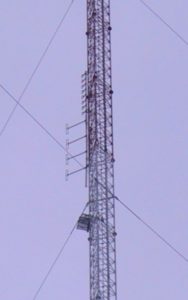
VHF receive/transmit antenna and UHF transmit antenna
The VHF antenna in this picture, a four-bay Sinclair folded dipole array, is the receive/transmit antenna for the W8GQN repeater. The eight-bay Sinclair antenna just above it is the UHF transmit antenna for the N8DNX and KO8P repeaters. All of these antennas share a single 7/8″ Heliax transmission line from here down to the transmitter room. While you can’t see it in the picture, somewhere in there is a TX/RX weather-proof band splitter that separates the VHF and UHF signals for the appropriate antennas.
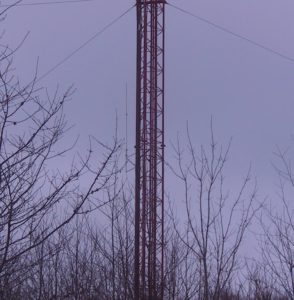
VHF/220/UHF Remote Base Antenna
This is the remote base antenna for 144 MHz through 450 Mhz. It’s a Diamond 3 band antenna that includes the 220 band. While it doesn’t look like it in this picture, this antenna is about at the height of all the surrounding treetops. From here, with 25 Watts from the FT-736R, we can link to repeaters more than 100 Miles away. It’s also pretty good for low-signal SSB work as well.
Due to the poor contrast on the day this picture was taken you may want to click on this image to see the antenna a bit better.
6 Meter Folded Dipole
Here on the right of the tower below the small yagi is the 6 Meter folded dipole element that’s used by the remote base. The day I took this picture was the day I noticed that this antenna has been hit by some falling ice. I guess hiding it under the other antennas didn’t do the trick. While it has a missing spacer insulator and is a bit bent, it’s still working. Looks like some repair work will be in order this spring.
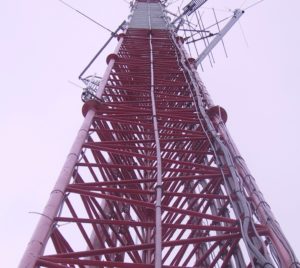
Weather Radio Receive Antenna
Close to the tower leg on the left side of the tower is the weather alert radio antenna. We chose an omni antenna for this because the weather alert radio can scan to an alternate frequency when it looses the primary channel. Unfortunately, neither weather transmitter comes in real well at this site. We’ve been working with the NWS to install a new weather transmitter in the club repeater room along with the repeaters, but as of yet that’s still bogged down at the NWS. We really need one here, and this would be a great location for it. Perhaps some day we’ll be able to use a tiny whip on the weather receiver and can retrieve this antenna.
